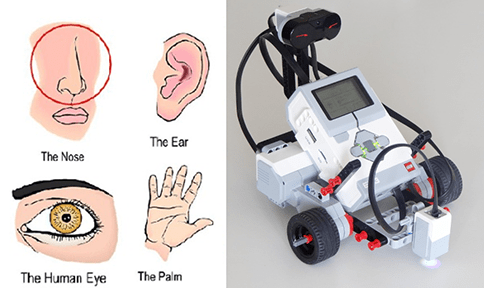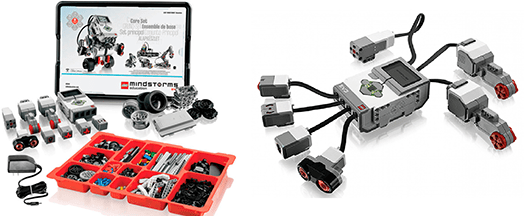
Summary
Through six lesson/activity sets, students learn about the functioning of sensors, both human and robotic. In the activities, student groups use LEGO® MINDSTORMS® EV3 robots and components to study human senses (sight, hearing, smell, taste, touch). They also learn about the human-made rotation, touch, sound, color and ultrasonic sensors. "Stimulus-sensor-coordinator-effector-response" pathways are used to describe the processes as well as similarities between human/animal and robotic equivalent sensory systems. The important concept of sensors converting/transducing signals is emphasized. Through assorted engineering design challenges, students program the LEGO robots to respond to input from various LEGO sensors. The overall framework reinforces the theme of the human body as a system with sensors—that is, from an engineering perspective. PowerPoint® presentations, quizzes and worksheets are provided throughout the unit.Engineering Connection
The studies of neuroscience and engineering show us how the human brain and sensors are similar to human-made computers and robots, in a functional sense. New findings show us that mathematical principles similar to those used in human brains and systems are useful for electrical, mechanical and biological engineers as they continue to devise better robots, computers and sensors. Engineer-designed sensors are used in a wide variety of applications, examples include speedometers, touchscreens, microphones, baby monitors, nightlights and medical ultrasound imaging. In growing fields such as biological engineering and systems neurobiology, engineers are becoming increasingly involved in human body research and efforts to replicate the functioning of its many systems. For instance, engineers are designing walking robots with sensors, artificial organs such as hearts and livers, and bio-sensors that monitor sugar levels for diabetics.
Computer programming is a component of many modern engineering designs. As students design robot programs throughout this unit, they start with a "goal" or "concept" of what the program solution needs to do and how, before they begin writing the code. Then, the process of working on the code and "debugging" it inherently constitutes "revising and improving their designs based on the results of testing." Thus, the thought processes required to code programs that meet problem constraints are very similar, if not identical, to the thought processes required for traditional engineering design of physical objects and products.
Unit Overview
This unit is composed of six lesson/activity pairs related to the functioning of human senses and robot sensors. The unit is the fourth in a series and follows Humans Are Like Robots (unit 1), Our Bodies Have Computers and Sensors (unit 2) and What Is a Computer Program? (unit 3).
Throughout this unit, each group of (2-4) students requires all or portions of the following items:
- LEGO MINDSTORMS EV3 robot, such as EV3 Core Set (5003400) at https://education.lego.com/en-us/products/lego-mindstorms-education-ev3-core-set/5003400#lego-mindstorms-education-ev3
- LEGO MINDSTORMS Education EV3 Software (most recent version), free online, you have to register a LEGO account first at https://www.lego.com/en-us/mindstorms/downloads/
- computer, loaded with EV3 Software (most recent version)
Specific and/or additional required materials are indicated in the individual lessons and activities.
Note: This activity can also be conducted with the older (and no longer sold) LEGO MINDSTORMS NXT set instead of EV3; see below for those supplies:
- LEGO MINDSTORMS NXT Base Set
- computer loaded with the NXT 2.1 software

Educational Standards
Each TeachEngineering lesson or activity is correlated to one or more K-12 science,
technology, engineering or math (STEM) educational standards.
All 100,000+ K-12 STEM standards covered in TeachEngineering are collected, maintained and packaged by the Achievement Standards Network (ASN),
a project of D2L (www.achievementstandards.org).
In the ASN, standards are hierarchically structured: first by source; e.g., by state; within source by type; e.g., science or mathematics;
within type by subtype, then by grade, etc.
Each TeachEngineering lesson or activity is correlated to one or more K-12 science, technology, engineering or math (STEM) educational standards.
All 100,000+ K-12 STEM standards covered in TeachEngineering are collected, maintained and packaged by the Achievement Standards Network (ASN), a project of D2L (www.achievementstandards.org).
In the ASN, standards are hierarchically structured: first by source; e.g., by state; within source by type; e.g., science or mathematics; within type by subtype, then by grade, etc.
See individual lessons and activities for standards alignment.
Subscribe
Get the inside scoop on all things TeachEngineering such as new site features, curriculum updates, video releases, and more by signing up for our newsletter!Unit Schedule
Each lesson and each activity is designed to take one 50-minute session, for a total of twelve 50-minute sessions for the unit. The suggested order to conduct the lesson/activity sets is shown below.
| Lesson 1: What Is a Sensor? | --> | Activity 1: Robot Sensors and Sound |
| Lesson 2: What Is a Motor and How Does a Rotation Sensor Work? | --> | Activity 2: Master Driver |
| Lesson 3: How Does a Touch Sensor Work? | --> | Activity 3: Music by Touch: Programming Robot Tactile Sensors to Play Sounds |
| Lesson 4: How Does a Sound Sensor Work? | --> | Activity 4: Control Using Sound |
| Lesson 5: How Does a Color Sensor Work? | --> | Activity 5: Follow the Light |
| Lesson 6: How Does an Ultrasonic Sensor Work? | --> | Activity 6: Ultrasonic Sensor Robot Design Project: Don't Bump into Me! |
More Curriculum Like This

Through the two lessons and five activities in this unit, students' knowledge of sensors and motors is integrated with programming logic as they perform complex tasks using LEGO® MINDSTORMS® robots and software. Through these design challenges, students become familiar with the steps of the engineer...

Students learn about how touch sensors work, while reinforcing their similarities to the human sense of touch. They look at human senses and their electronic imitators, with special focus on the nervous system, skin and touch sensors.

Students learn about electric motors and rotational sensors. They learn that motors convert electrical energy to mechanical energy and typically include rotational sensors to enable distance measuring. Students create a basic program using the LEGO® MINDSTORMS® interface to control a motor to move a...

Through four lesson and four activities, students are introduced to the logic behind programming. Starting with very basic commands, they develop programming skills while they create and test programs using LEGO® MINDSTORMS® robots. The unit is designed to be motivational for student learning, so th...
Copyright
© 2013 by Regents of the University of Colorado; original © 2013 Curators of the University of MissouriContributors
Nishant Sinha; Trisha Chaudhary; Srijith Nair; Pranit Samarth; Satish S. NairSupporting Program
GK-12 Program, Computational Neurobiology Center, College of Engineering, University of MissouriAcknowledgements
This curriculum was developed under National Science Foundation GK-12 grant no. DGE 0440524. However, these contents do not necessarily represent the policies of the National Science Foundation, and you should not assume endorsement by the federal government.
Last modified: October 17, 2020







User Comments & Tips